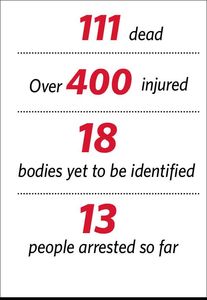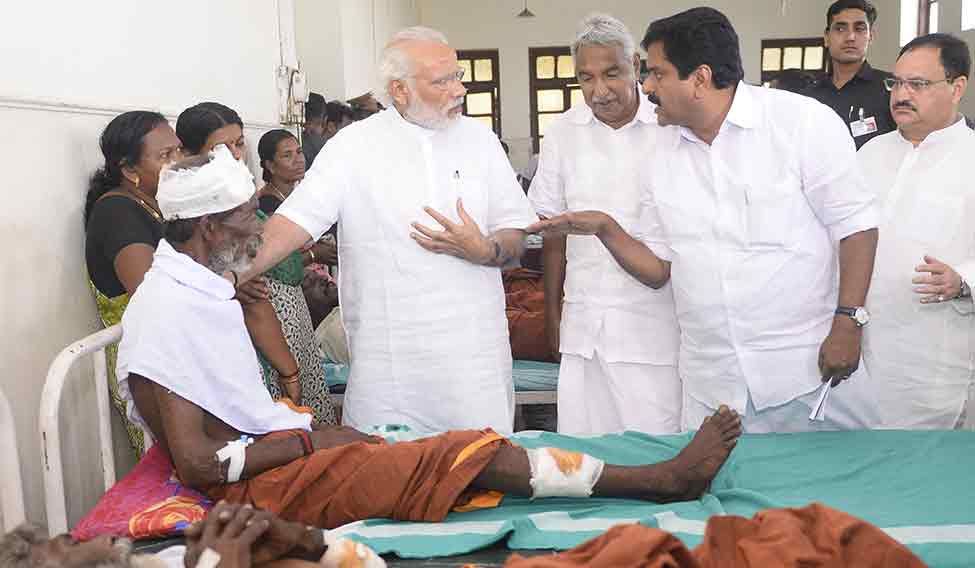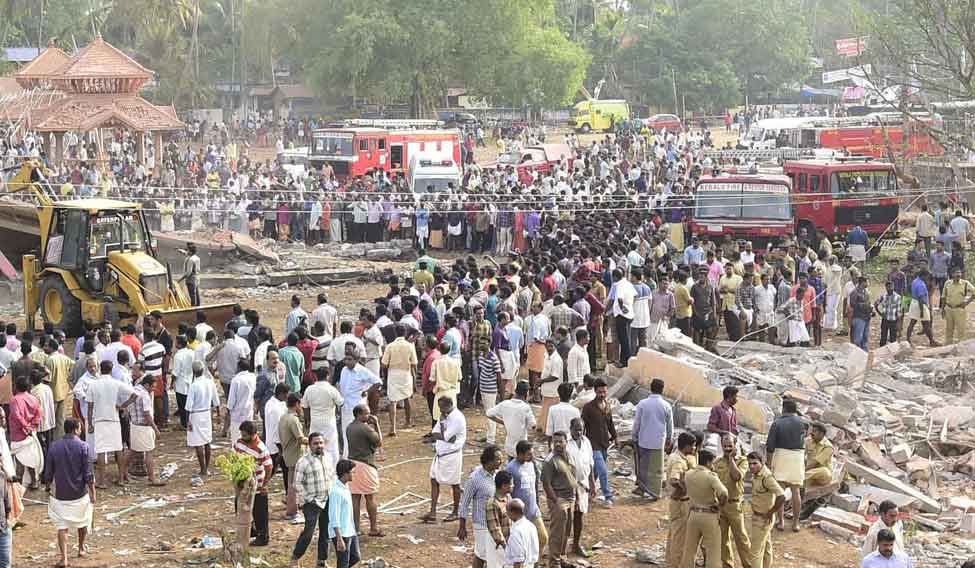On April 11, Kerala Chief Minister Oommen Chandy was in Kasaragod, the northern-most district of the state. He left Kasaragod late in the evening by train, reaching Thiruvananthapuram early next morning right on time for an emergency meeting at the government medical college. The meeting was held to evaluate the progress of the rehabilitation efforts following the fireworks tragedy at Puttingal temple near Paravoor in Kollam district, which took place in the wee hours of April 10. The chief minister, in fact, arrived at the medical college even before many of the other participants turned up.
The response of the political leadership to the fireworks tragedy has been commendable. Chandy arrived at the site in the morning itself. Prime Minister Narendra Modi rearranged his schedule and arrived at Paravoor within 12 hours of the accident. Congress vice president Rahul Gandhi followed him, sharing the grief of the state and consoling the victims.
Fireworks contests have long been an integral part of religious festivals in Kerala. Many temples and churches across the state host such contests in which faith, fervour and traditions trump everything else, including safety norms. Accidents, therefore, are not uncommon. In the last 20 years, there have been 15 major fireworks accidents in Kerala, which have resulted in 92 deaths. But the Paravoor tragedy surpassed them all, with 111 people losing their lives and more than 400 suffering injuries, with a number of them in a critical stage.
The Meena Bharani, celebrated in honour of the Mother Goddess (Kali), is one of the major festivals in Kerala. The festivities go on for ten days and conclude on the Meena Bharani day with competitive fireworks. Being one of the largest fireworks displays in south Kerala, and with a tradition dating back to centuries, the Paravoor contest has been close to the hearts of the local people.
When the fireworks contest formally started at 11:55pm on April 9, nearly 15,000 people were at the temple premises, trying to find better vantage points to take in the sights and sounds. For the next three hours, the two competing teams set alight a variety of custom-made bangers, mortar mines and cakes, increasing progressively in intensity. The crowds were enthralled as both teams displayed their skills, turning the night sky brighter and louder. Tragedy struck a few minutes past 3am, when a banger burst low in the air, with sparks raining down in all directions. It hit the nearby concrete storehouse, causing the remaining explosives and the building to explode in a matter of seconds. Those who were standing close to the store were charred to death, while the debris flew in a radius of about two kilometres, hitting people, killing or maiming them. Even a person who was riding a bike nearly two kilometres away from the accident site was hit by a concrete block. He succumbed to injuries a few hours later.

It took some time before the survivors realised what had happened. With power supply disconnected, rescue operations were launched with light from mobile phones and then with the help of headlights of vehicles. There were hardly any ambulances to move the victims to hospitals. The first set of injured were taken in commuter buses parked nearby, which were waiting to ferry passengers back home when the fireworks were over. By dawn, the enormity of the devastation became clearer. Charred bodies, severed limbs and collapsed buildings could be seen everywhere. Even after three days, 18 bodies remained unidentified as they were torn into fragments. The government plans to do DNA testing to identify them.
After he visited the site, Chandy held an emergency cabinet meeting in Kollam. Modi came in the afternoon along with a team of specialist doctors from Delhi, after dispatching a medical team in the morning. Union Health Minister J.P. Nadda was asked to stay back in Kollam and coordinate rescue operations. The state government announced a compensation of Rs 10 lakh each for the next of kin of the dead and Rs 2 lakh for those injured, while the Union government promised Rs 2 lakh and Rs 50,000, respectively. A number of business, religious and community leaders have also announced compensations.
The death of 111 innocent people has brought to the fore several uncomfortable questions. Kollam district collector A. Shainamol said the fireworks were held despite a ban by the district administration. She said the ban order was issued after the district police filed a report on April 6, citing safety concerns. Two days later, on April 9, the police filed another report, okaying the fireworks. The district administration, however, refused to lift the ban. The police said they were “misled” by the temple authorities, who assured that there would be no competition this year, but only a display of fireworks with gunpowder weighing just 12kg. Shainamol found a great deal of support on social media for her stand. Her IAS colleague and Kozhikode district collector N. Prasanth said magisterial orders needed to be respected by everyone including the police department. “The district magistrate cannot be dealt with so lightly.”
The Paravoor fireworks also went against a 2005 order by the Supreme Court which had banned the bursting of sound-emitting crackers between 10am and 6pm. A bench comprising chief justice R.C. Lahoti and justice Ashok Bhan had even rejected the argument that bursting firecrackers had a religious significance.
At Paravoor, even the basic safety norms were not adhered to and the police paid no attention. For instance, the norms regarding maintaining a minimum distance of 40 metres between the storehouse of firecrackers and the ground where the display was held, were ignored. The provision that there should not be any building within a 100-metre radius of the storehouse was also ignored. Moreover, the police failed to keep the people at a safe distance—100 metres as prescribed by relevant laws—away from the storehouse and the display ground. Hundreds were standing perilously close to bursting crackers and the storehouse when the accident happened. According to Muralee Thummarukudi, who heads the United Nations Environment Programme's disaster risk reduction, crowd control was among the major challenges faced during fireworks displays in Kerala, more so because of the lack of space and the increasing number of people who throng such venues.
Petroleum and Explosives Safety Organisation officials, who arrived in Paravoor after the accident, suspect that banned chemicals like potassium chlorate were used. Potassium chlorate, a cheap substitute for potassium nitrate and sodium nitrate, makes crackers louder and brighter, but the compound is unstable and highly dangerous. There are also questions about the quantity of the chemicals used. Although explosive rules permit the use of only 15kg of gunpowder, during a number of major festivals in Kerala, around 40 tonnes are believed to be used. Although the flouting of rules was blatant, the police failed to act effectively.
The police have not yet ruled out sabotage. Additional director-general of police S. Ananthakrishnan, who heads the team of investigators, said the police were keeping all options open. Suspicions of sabotage intensified after three cars laden with high intensity explosives were found abandoned half a kilometre from the temple. It was later confirmed that one of them had fake registration numbers.
Apart from the investigation by the crime branch, the government has also ordered a judicial inquiry by a retired High Court judge, Krishnan Nair.
It was official ineptitude that possibly prompted the High Court to take suo motu cognisance of the issue, based on a letter written by Justice V. Chidambaresh. On April 12, the court passed an interim order banning loud fireworks at night, based on the 2005 order of the Supreme Court, and limited the sound of fireworks during the day to 140 decibel. It said the Paravoor tragedy was the result of the failure of the government machinery and asked the government to slap murder charges on those found responsible. The court asked the government to file an affidavit about the tragedy. When the government asked for ten days to submit the affidavit because of Vishu holiday, the court posted the next sitting at 4pm on April 14, the day of Vishu. It also asked the government to investigate whether there were any anti-national forces behind the mishap.
Several religious leaders and organisations have called for a ban of fireworks. Heads of most prominent churches have called for a ban in their communities. But there is also opposition to a blanket ban. Chandy factored in this dilemma when he told THE WEEK that “there were people and groups who were in support of fireworks because of the traditions, beliefs and rituals involved. However, the Paravoor tragedy should make all of us think.” Chandy said the government would hold an all-party meeting on April 14 to discuss the issue. Spiritual leader Matha Amritanandamayi, however, had no such doubts. “Firecrackers are used only for the happiness of men, not God,” she said. “God is not deaf. So I would say it is best to ban it completely.”
WITH NAVIN J. ANTONY













